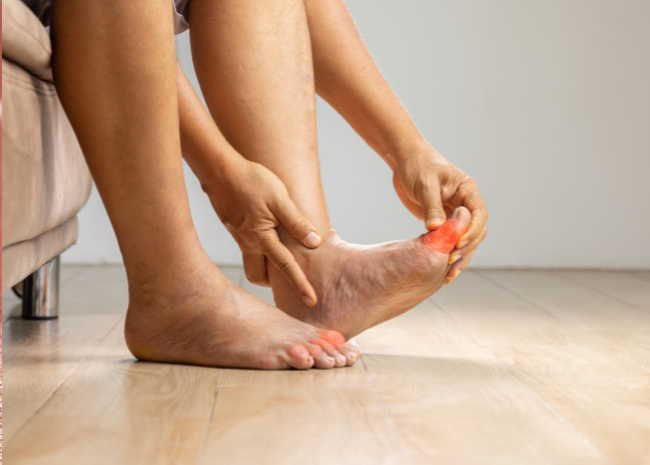
Can Exercise Cause Gout Flare-Up?
Answer: The fact is, while exercise itself does not directly cause a gout flare-up, high-impact or strenuous activities can trigger or worsen an existing flare-up by putting additional stress on the joints.
This is because gout brings severe joint pain from uric acid crystals, making exercise a challenge.
To stay active without worsening your symptoms, you need a tailored exercise plan.
In this article, we’ll discuss:
- What is gout
- How to manage gout attacks
- Recommended exercises for gout management
- Benefits of personalizing your exercise program
Ready to stay fit while protecting your joints? Let’s dive in.
First, What is Gout?
Gout is a form of arthritis where uric acid crystals build up in the joints, causing sudden, severe pain and swelling.
- This acid leads to the formation of crystals in the joints, particularly affecting the big toes, elbows, and other areas.
- The crystals cause inflammation and significant pain, especially when the affected joints are flexed.
- The accumulation of these sharp crystals can lead to sudden and severe pain, often occurring at night or after consuming certain foods and drinks.
The Challenge of Exercising with Gout
For individuals with gout, choosing the right exercises and timing is complicated due to the pain and inflammation caused by uric acid crystals.
High-impact workouts can exacerbate symptoms, making it essential to approach exercise carefully.
It’s crucial to find a balance that allows you to stay active while minimizing the risk of worsening your symptoms.
Managing Gout Attacks
Immediate Care During an Attack
When a gout attack occurs, the primary goal is to reduce inflammation.
This involves:
- Resting the affected joints
- Applying ice
- Using anti-inflammatory medications as prescribed by your physician
During an attack, avoid any form of exercise that puts stress on the affected joints. Instead, focus on managing the inflammation with the strategies mentioned above.
Avoiding High-Impact Exercise
Engaging in high-impact exercise during an attack can intensify pain and potentially worsen the condition.
It’s crucial to follow your physician’s advice on managing physical activity during these times.
Opt for low-impact activities and consult with a healthcare provider before resuming your usual exercise routine.
Recommended Exercises for Gout Management
When dealing with gout, choosing the right exercises can help manage symptoms and maintain your overall fitness.
The key is to focus on low-impact activities that minimize stress on your joints while still providing the benefits of exercise. Incorporate these exercises into your routine to stay active without worsening your condition.
– Stretching Exercises
We can teach you stretching exercises designed to gently move your joints through their full range of motion.
These exercises help maintain flexibility without putting undue stress on the affected joints.
Incorporating gentle stretching into your daily routine can also aid in preventing future attacks by keeping your joints limber and reducing stiffness.
– Low-Impact Endurance Exercises
- Swimming: Provides a full-body workout with minimal impact on the joints, as the water supports your body. The resistance of the water also helps in building strength without straining your joints.
- Cycling: An excellent alternative to running or jogging, as it reduces the impact on your feet and joints. Cycling can be adjusted to your fitness level and is particularly beneficial for maintaining cardiovascular health while protecting your joints.
– Additional Safe Exercises for People with Gout:
- Walking: A gentle way to stay active without straining your joints.
- Elliptical Training: Mimics walking but with reduced impact.
- Chair Exercises: Includes seated leg lifts and upper body stretches.
- Tai Chi: Gentle, flowing movements that improve flexibility and balance.
These activities help you maintain fitness without adding extra strain to your joints. Consult with your healthcare provider to tailor these exercises to your needs and ensure they fit your personal condition.
Personalizing Your Exercise Program
To effectively manage gout, it’s essential to tailor your exercise routine to fit your specific needs and condition.
A one-size-fits-all approach doesn’t work here; instead, personalizing your program can help you stay active while minimizing discomfort and preventing flare-ups.
By adapting exercises to your unique situation, you can improve your overall well-being and manage symptoms more effectively.
– Adjusting to Your Specific Needs
While gout commonly affects the big toe, it can also impact other joints, either individually or in combination. This is why it’s essential to tailor your exercise routine to how you are personally affected by the disease.
Be sure to monitor how different exercises impact your symptoms and adjust your routine accordingly to avoid exacerbating your condition.
– Developing a Customized Program
Our physical therapists can create a personalized exercise program aimed at reducing the frequency and intensity of gout attacks. Proactive exercise can alleviate painful symptoms and enhance your quality of life.
Our approach includes evaluating your specific needs and crafting a plan that adapts to changes in your condition, ensuring ongoing effectiveness and comfort.
Did you know you have Direct Access* to Physical Therapy? No referral, no problem!
Seeking Professional Guidance
Call us to schedule an appointment when you are diagnosed with gout or experience a flare-up. Proper guidance and a well-designed exercise program can significantly benefit your management of the condition.
Early intervention and tailored exercise plans can make a significant difference in controlling symptoms and improving overall well-being.
The Jackson Clinics serves 18 locations throughout Northern Virginia.
Find one near you: https://thejacksonclinics.com/locations/

